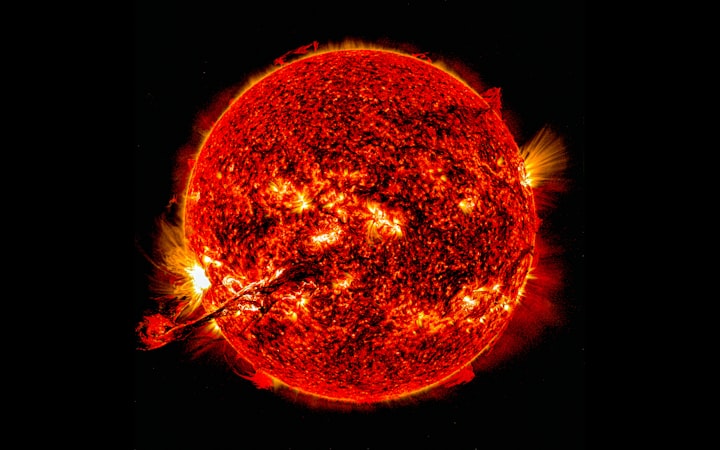What Would Happen if a Solar Storm Hit Earth?
We almost found out in 2012. On 23 July that year, a huge blazing cloud of hot plasma erupted from the sun and caught a solar wind headed directly to Earth.

An extreme solar storm — known as a coronal mass ejection (CME) — can eject as much as one billion tons of plasma from the sun’s surface at speeds up to 1.6 million kilometres per hour. Fortunately, the 2012 CME narrowly missed our blue planet. But it was too close for comfort, and it got scientists thinking about what would have happened if it had impacted Earth.
Scientists believe if the 2012 CME had impacted Earth, it would have caused three waves of damage. First, we’d have noticed radio blackouts and GPS navigation errors due to X-rays and ultraviolet radiation breaching the upper layers of our atmosphere.
Then the arrival of accelerated electrons and protons would have acted kind of like a massive electrical charge through our atmosphere. This would have fried satellites and sent some spiraling out of orbit.
But that would have been only the beginning. In the third phase, billions of tons of magnetised plasma would have caused widespread power blackouts, and even completely burnt out huge power transformers.
According to the National Academy of Sciences, a direct hit by a CME the size of the one that narrowly missed Earth in 2012 could cause more than $2 trillion worth of damage. That’s 20 times greater than the cost of damage caused by Hurricane Katrina.
So what are the consequences of this damage for our cities and towns? This, of course, depends on the severity of the CME, but an extreme solar storm could cause serious havoc.
With GPS navigation systems disabled, planes would be grounded and logistics systems would be offline. Radio and TV stations would be unable to broadcast. Cities and towns would be without power, sewerage plants would be inoperable, and digital payments would be defunct.
There would be no power to your home, your internet would be out, and your landline wouldn’t work. You’d be unable to fill your car with fuel; you’d have no access to cash via banks and ATMs; supermarkets would be without power and dealing with a massive collapse in the supply chain; and the greater economy would grind to a halt.
The cost on human health could be great too. Radiation from a severe solar storm could cause organ damage, radiation sickness and cancer. If the CME was large enough, it could essentially mimic the effects of radioactive fallout from the meltdown of a nuclear power station.
And if you want to step into the full nightmare scenario, a CME could even trigger a full-scale nuclear war. In 1967 a powerful solar flare jammed surveillance radars in Alaska, Greenland and the UK. This was at the height of the Cold War, and the US military thought the radar jam may have been signaling an imminent Soviet nuclear attack.
Nuclear-armed aircraft were authorised to mount a catastrophic response — until scientists intervened at the last moment with evidence of a solar flare as the radar-jamming culprit.
The US military de-escalated and nuclear war was prevented. But the situation is evidence of the widespread, unexpected and potentially catastrophic impact a severe CME could have on Earth.
So how likely is it that an extreme solar storm will impact Earth? Well, that really depends on who you ask.
According to physicist Pete Riley, the chances of a Carrington-class solar storm impacting Earth are higher than you might expect. His analysis concluded that there is a 12 percent chance of an extreme CME hitting Earth by 2024.
However, a different 2019 study argues the chance of a Carrington-class solar storm impacting Earth by 2029 is between just 0.46 percent and 1.88 percent.
And on the alarmist end of the scale, in 2015 the executive director of the Electromagnetic Pulse Task Force on National Homeland Security told the US Congress that prolonged damage to the power grid could cause widespread starvation, disease and societal collapse that could kill 90 percent of the US population.
What we do know for sure is that the sun completes a solar cycle every 11 years. Solar storm activity builds during these cycles. Solar Cycle 25 began in December 2019, and is predicted to experience its peak storm activity in July 2025.
So, if the numbers are accurate, we’re talking about a small chance of potentially mass devastation. Shutting down power grids before a CME strikes could prevent much of that damage, and scientists are working to extend forecast timelines to give power plants and other utilities more time to respond.
Read the full story:
About the Creator
Shane Peter Conroy
Shane is just another human. He writes, he paints, he reads. He once got his tongue stuck to the inside of a freezer. Actually, he did it twice because he thought the first time might have been a fluke. https://themalcontent.substack.com
Reader insights
Nice work
Very well written. Keep up the good work!
Top insights
Easy to read and follow
Well-structured & engaging content
Eye opening
Niche topic & fresh perspectives
Excellent storytelling
Original narrative & well developed characters
Expert insights and opinions
Arguments were carefully researched and presented
On-point and relevant
Writing reflected the title & theme







Comments
There are no comments for this story
Be the first to respond and start the conversation.